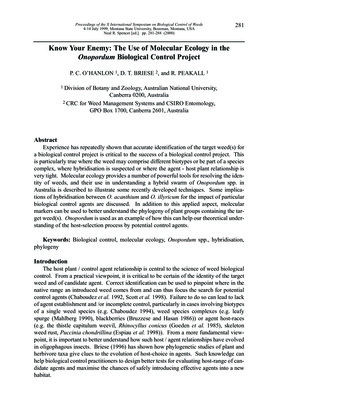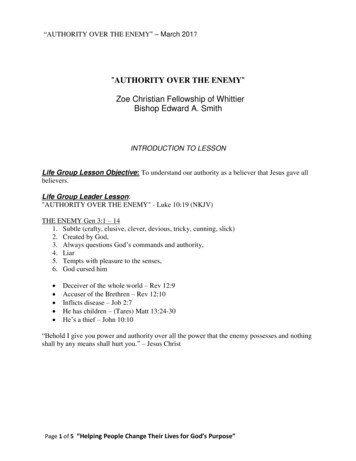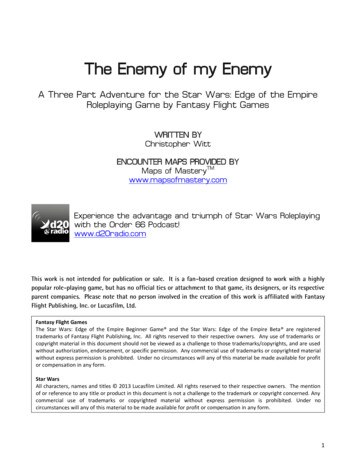
Transcription
Proceedings of the X International Symposium on Biological Control of Weeds4-14 July 1999, Montana State University, Bozeman, Montana, USANeal R. Spencer [ed.]. pp. 281-288 (2000)281Know Your Enemy: The Use of Molecular Ecology in theOnopordum Biological Control ProjectP. C. O’HANLON 1, D. T. BRIESE 2, and R. PEAKALL 11 Divisionof Botany and Zoology, Australian National University,Canberra 0200, Australia2 CRC for Weed Management Systems and CSIRO Entomology,GPO Box 1700, Canberra 2601, AustraliaAbstractExperience has repeatedly shown that accurate identification of the target weed(s) fora biological control project is critical to the success of a biological control project. Thisis particularly true where the weed may comprise different biotypes or be part of a speciescomplex, where hybridisation is suspected or where the agent - host plant relationship isvery tight. Molecular ecology provides a number of powerful tools for resolving the identity of weeds, and their use in understanding a hybrid swarm of Onopordum spp. inAustralia is described to illustrate some recently developed techniques. Some implications of hybridisation between O. acanthium and O. illyricum for the impact of particularbiological control agents are discussed. In addition to this applied aspect, molecularmarkers can be used to better understand the phylogeny of plant groups containing the target weed(s). Onopordum is used as an example of how this can help our theoretical understanding of the host-selection process by potential control agents.Keywords: Biological control, molecular ecology, Onopordum spp., hybridisation,phylogenyIntroductionThe host plant / control agent relationship is central to the science of weed biologicalcontrol. From a practical viewpoint, it is critical to be certain of the identity of the targetweed and of candidate agent. Correct identification can be used to pinpoint where in thenative range an introduced weed comes from and can thus focus the search for potentialcontrol agents (Chaboudez et al. 1992, Scott et al. 1998). Failure to do so can lead to lackof agent establishment and /or incomplete control, particularly in cases involving biotypesof a single weed species (e.g. Chaboudez 1994), weed species complexes (e.g. leafyspurge (Mahlberg 1990), blackberries (Bruzzese and Hasan 1986)) or agent host-races(e.g. the thistle capitulum weevil, Rhinocyllus conicus (Goeden et al. 1985), skeletonweed rust, Puccinia chondrillina (Espiau et al. 1998)). From a more fundamental viewpoint, it is important to better understand how such host / agent relationships have evolvedin oligophagous insects. Briese (1996) has shown how phylogenetic studies of plant andherbivore taxa give clues to the evolution of host-choice in agents. Such knowledge canhelp biological control practitioners to design better tests for evaluating host-range of candidate agents and maximise the chances of safely introducing effective agents into a newhabitat.
282O’Hanlon et al.Techniques used in biological control projects where the identity of and relationshipsbetween organisms have been studied vary from morphology (Hull and Groves 1973),chromosome counts (Morrison and Scott 1995), plant secondary chemicals (Mahlberg1990) and protein electrophoresis (Goeden et al. 1985, Morrison and Scott 1996).However, recent developments in molecular techniques give the biological control practitioner a selection of powerful tools for resolving the identity and relationships of both target weed and candidate agent (see reviews by Nissen et al. 1995, O’Hanlon and Peakall,2000). The increased power of these methods is demonstrated by a recent study on blackberries by Evans et al. (1998), who, using DNA markers, identified 20 genotypes from 13previously described morphological taxa (e.g. Evans et al. 1998). The importance of thisknowledge is obvious in the light of differential susceptibility to a rust fungus controlagent by different members of the blackberry species complex (Bruzzese and Hasan1986).The present paper describes the use of molecular techniques to clarify doubts concerning the identity of Onopordum spp. thistles in Australia and demonstrate the existenceof widespread hybridisation between species. In doing so it discusses the implications ofsuch hybridisation for the Onopordum biocontrol project. The use of molecular techniquesto demonstrate phylogenetic relationships both within the genus Onopordum and betweenOnopordum and other genera of the Carduinae thistles is also described, and the importance of knowing such relationships is discussed in terms of seeking to better understandhost-range restrictions of candidate biological control agents.Identity of Australian OnopordumPastures in south-eastern Australia are considered to have been invaded by two speciesof Onopordum of European origin, Scotch thistle (O. acanthium L.) and Illyrian thistle (O.illyricum L.) (Parsons and Cuthbertson 1992). These weedy thistles are currently the target of a biological control project (Woodburn and Briese 1996). However, there has beensome doubt concerning the identity of some populations (see Groves et al. 1990), as morphological analysis revealed that many infestations of Onopordum in Australia did notcorrespond with any of the known species. Instead, they were morphologically verydiverse, but generally intermediate between O. acanthium and O. illyricum. AmplifiedO. bracteatumO. acanthiumAustralianOnopordumO. illyricum O. argolicumO. corymbosumO. tauricumO. acaulonO. macracanthumO. nervosumFig. 1.Non-metric multidimensional scaling scatterplotof genetic distances between AustralianOnopordum and putative European source taxa(shaded). Circles indicate individual Australianpopulations.
Molecular ecology in Onopordum biocontrol283fragment length polymorphism (AFLP) was therefore used to determine the uniqueness ofAustralian Onopordum populations, whether they are descended from hybridisationbetween Scotch and Illyrian thistles, and how closely related they are to other species ofOnopordum.Of more than 100 polymorphic DNA fragments generated by AFLP, those diagnosticfor Scotch and Illyrian thistles were demonstrated to segregate in putative hybrids, confirming their hybrid origin (Fig. 1) (O’Hanlon et al. 1999). Genetic exchange betweenthese thistles may confer a fitness advantage to weedy Onopordum in the new Australianenvironment (see Vila and d’Antonio 1998), and also contribute to adaptive variation inthe group. Indeed, preliminary transplant experiments suggest that hybrid genotypes havehigher fitness in certain contexts and a demographic genetic study revealed heterozygoteadvantage within a hybrid population (O’Hanlon, unpublished data).The existence of widespread hybridisation amongst Onopordum in Australia also hasimplications for the management of these weedy thistles, as the wide variability exhibited in certain plant characters may effect control methods, including the use of biologicalcontrol agents, and their impact (Table 1). For example, both parent species ofTable 1.Differences between parental Onopordum taxa that could effect the impact ofbiological and other control methods on hybrid populations(hybrids have variable intermediate O. acanthiumO. illyricumPossible effect selection of best-adapted hybridadapted to cooleradapted to warmercontinentalMediterraneanclimatesclimates hybrid vigourfacultative rosette feeding by agents may lead tobiennialperennialpopulations in all infested localitiesvarying degrees of perenniation with flowon effects for plant life-cycleCapitulaArchitecturemore, smaller,fewer, larger,shorter time tolonger time to differential oviposition patterns andmaturitymaturity differential impact on seed productionbushy, highlymore open, fewer differential survival of stem feedingbranchedbranchessurvival of seed-feedersagents differential exposure of agents topredationLeaf structurebroader withindented with lessdense woollydense tomentosumtomentosum differential protection for eggs laid onleaves differential palatability to grazing stock differential uptake of herbicides
284O’Hanlon et al.Onopordum are monocarpic, but O. acanthium is a strict biennial while O. illyricum is afacultative perennial. Rees et al. (1999) found that in O. illyricum bolting is dependent onrosettes reaching a critical size, so that stresses such as rosette herbivory may reduce plantsize and thus promote perenniation of rosettes. Three such rosette-feeding agents havebeen released, the weevil Trichosirocalus sp. nov., the moth Eublemma respersa and thefly, Botanophila spinosa, each with slightly different feeding niches and periods of attack.Perenniation induced by these agents could favour their population build-up by maintaining resource levels, but may also have complex flow on effects, through reduced seed production and input into soil seed reserves, which could affect capitulum attacking (the weevil, Larinus latus) or stem-boring agents (the weevil, Lixus cardui). Another importantdifference between the two parent species is that O. illyricum has much larger capitula,which favours survival of L. latus (Briese 1996). Hybrid forms tend to show variability incapitulum size and number as well as varying degrees of perenniation (Pettit et al. 1996),and the presence of wide genetic variability in these and other characters will undoubtedcompound the plant / herbivore interactions alluded to above. Moreover, it could lead toselection for particular plant traits under continued herbivore pressure from introducedagents. Variability in other characters such as leaf form and texture may also affect palatability and chemical uptake of hybrid thistle populations (see Pierce 1996), which needs tobe considered in the integration of biological control with tactical grazing and herbicides,such as described by Huwer et al. (1999) for Onopordum thistles.Phylogeny of European OnopordumA previous taxonomic treatment of morphological variation in European Onopordumdefined two subgenera, Onopordum comprising four sections, and Acaulon, comprising asingle section (Amaral Franco 1975). However, phylogenetic analyses of AFLP datafound this to be an unnatural classification, with section Echinata being non-monophyletic. In addition, the solitary species from section Acaulon, O. acaulon, grouped withother species in rather than forming a separate clade, as suggested from morphologicalstudies. The AFLP phylogeny is supported by biogeographic evidence as the differentclades correspond to regional distributions of Onopordum spp. in Europe (Fig. 2).Fig. 2. AFLP and morphological phylogenies of nine European species of Onopordum (Cynaraspp. used as outgroups).MorphologyAFLPCynara(OUTGROUP )O. acaulonacaulonAAO. nervosumO.nervosumO.macrocanthumO. macrocanthumO. corymbosumcorymbosumO. tauricumO.tauricumO. argolicumO.argolicumBBO. bracteatumO.bracteatumO. illyricumO.illyricumO. acanthiumacanthiumCA species restricted to Iberian peninsulaB species occurring Aegean regionC widespread species
Molecular ecology in Onopordum biocontrol285Some Onopordum species showing strong morphological and habitat affinities areonly distantly related. The discordance between molecular and morphological analysesmay result from a pattern of colonisation and evolution (O’Hanlon et al. 1999). Given thatthe genus is considered to have originated in central Asia, it could be hypothesised thatOnopordum species invaded continental Europe from the east. During colonisation, different species hybridised, resulting in genetically diverse founder populations. The IberianPeninsula and Aegean regions became isolated, and speciation within these regionscaused sorting of adaptive traits with ecological preferences, resulting in convergent morphological evolution. Some subsequent spread of species such as O. illyricum may haveoccurred along ecoclinal corridors such as the Mediterranean coastal strip. This proposedevolutionary pathway for European Onopordum spp. is concordant with the speciation ofa group of capitulum-feeding weevils of the genus Larinus into eastern and westernEuropean taxa specialising on the genus Onopordum (see Briese et al. 1996).Such “lineage sorting” is supported by the recurrent formation of hybrids in Europe(Gonzales Sierra et al. 1992) and the continual gene flow between species (O’Hanlon etal. 1999). This may help explain why the oligophagous insect fauna found on Onopordumspp. remains genus specific (Briese et al. 1994) rather than having developed more specialised relationships with individual species.Phylogenetic relationships between thistlesKnowledge of the phylogenetic relationships of target weeds and related plants isimportant considering the need for very high degrees of specificity in biological controlagents, particularly given current concern for non-target impacts (see Louda et al. 1997).Thistles appear to be a modern group with genera diverging relatively recently.Consequently, relationships between thistles have been difficult to resolve. Different datasets produced phylogenetic trees that, while differing in the levels of resolution obtained,were mostly congruent (Fig. 3). When combined, a “total evidence” tree produced a moreFig. 3. A “total evidence,” chloroplast, and AFLP strict consensus tree. Bootstrap values givenabove branches. Grey branches indicate bootstrap values 50%.cpDNA and morphologyTotal SilybumCirsiumSilybumGalactitesNotobasisPicnomon
286O’Hanlon et al.fully resolved than trees produced from individual data sources, with strong support forseveral clades. Arctium-Cousinia formed a monophyletic stem group to the remaininggenera which were divided into two clades; (1) relatives of Carduus and (2) relatives ofCynara. Within the former clade, Picnomon-Notobasis, Carduus-Tyrimnus, and SilybumGalactites were identified as sister genera. Within the latter clade, relationships betweenCynara, Ptilostemon and Onopordum remained unresolved.Despite uncertainty within the clade, it is clear that Cynara and Ptilostemon are moreclosely related to Onopordum than are the other genera. Following Wapshere’s (1974)centrifugal phylogenetic testing procedure, this justifies the use of Cynara species as keytest plants to determine whether it is worth pursuing a more generalised and expensivehost-testing protocol. The restriction of a group of closely related seed weevils within thegenus Larinus to the Cynara-Onopordum clade also supports this and provides clues tothe evolution of host-choice (Briese et al. 1996).ConclusionsDNA markers have proved a powerful tool to better understand the system in whichbiological control of Onopordum spp. is being attempted. They provided, either alone orthrough combination with other character sets, a clearer picture of past and current evolution of this group of thistles, and the importance of hybridisation in this process. Moreprecise knowledge of the phylogenetic relationships of Onopordum spp. have given a better idea of how the natural enemies of this group of thistles evolved with their hosts. Theability to unravel the existence of hybridisation and the extent of its occurrence inAustralia means that researchers can better anticipate agent impact and modify controlstrategy if needed.Despite their power, the use of molecular techniques for better understanding the biology of weeds is often inhibited by the lack of expertise, and the time and cost involved inperforming such studies. Furthermore, such costs are rarely included in biocontrol projectbudgets and often the benefits are not considered sufficiently important by outcome-oriented funding sources. As in this case study of Onopordum, this problem can be resolvedthrough collaboration with researchers interested in plant population genetics and evolution. Weed biological control, through targeting invasive plant species and through thedeliberate transfer of organisms to new habitats, can provide excellent models for studyin these important fields of considerable current research interest. In return, the biologicalcontrol practitioner can obtain a much clearer picture of the system he hopes to manipulate.AcknowledgmentsFunding for this project was provided by the Australian National University and theCooperative Research Centre for Weed Management Systems.ReferencesAmaral Franco, J. 1975. Onopordum L., pp. 244-248. In T.G. Tutin et al. [eds.], Flora Europeavol. 4.Briese, D.T. 1996. Phylogeny: can it us to help understand host-choice by biological controlagents?, pp 63-70. In V.C. Moran, and J.H. Hoffman [eds.], Proceedings, 9thInternational Symposium on Biological Control of Weeds, 19-26 Jan 1996,Stellenbosch, South Africa. UCT, Cape Town.
Molecular ecology in Onopordum biocontrol287Briese, D.T., A.W. Sheppard, H. Zwölfer, and P.E. Boldt. 1994. The phytophagous insectfauna of Onopordum thistles in the northern Mediterranean basin. Biol. J. Linn. Soc.53: 231-253.Briese, D.T., C. Espiau, and A. Pouchot-Lermans. 1996. Micro-evolution in the weevil genusLarinus: host-race formation and speciation. Mol. Ecol. 5: 531-545.Bruzzese, E., and S. Hasan. 1986. Collection and selection in Europe of isolates ofPhragmidium violaceum (Uredinales) pathogenic to species of European blackberrynaturalised in Australia. Ann. Appl. Biol. 108: 527-533.Chaboudez, P. 1994. Patterns of clonal variation in skeleton weed (Chondrilla juncea), anapomictic species. Aust. J. Bot. 42: 283-295.Chaboudez, P., S. Hasan, and C. Espiau. 1992. Exploiting the clonal variability of Chondrillajuncea to collect virulent strains of Puccinia chondrillina for use in Australia, pp.118-121. In Proceedings, 1st International Weed Congress, Melbourne, Australia, Vol. 2.Espiau, C., D. Riviere, J.J. Burdon, S. Gartner, B. Daclinat, S. Hasan, and P. Chaboudez.1998. Host-pathogen diversity in a wild system - Chondrilla juncea and Pucciniachondrillina. Oecologia 113: 133-139.Evans, K.J., D.E. Symon, and R.T. Roush. 1998. Taxonomy and genotypes of the Rubusfruticosus L. aggregate in Australia. Plant Prot. Quart. 13: 152-156.Goeden, R.D., D.W. Ricker, and B.A. Hawkins. 1985. Ethological and genetic differencesamong three biotypes of Rhinocyllus conicus (Coleoptera: Coleoptera) introduced intoNorth America for the biological control of asteraceous thistles, pp. 181-189. In E.S.Delfosse [ed.], Proceedings, 6th International Symposium on Biological Control ofWeeds, 19-25 August 1984, Vancouver, Canada, Agriculture Canada, Ottawa.Gonzalez Sierra, G., C. Perez Morales, A. Peñas Merino, and S. Rivas-Martinez. 1992.Revisión taxonomica de las especies ibericas del género Onopordum L. Candollea47: 181-213.Groves, R.H., J.J. Burdon, and P.E. Kaye. 1990. Demography and genetics of Onopordum insouthern New South Wales. J. Appl. Ecol. 18: 649-658.Hull, V.J., and R.H. Groves. 1973. Variation in Chondrilla juncea L. in south-eastern Australia.Aust. J. Bot. 21: 113-135.Huwer, R.K., D.T. Briese, A.W. Sheppard, T.L.Woodburn, W.M. Lonsdale, D. Kemp, P.Dowling, D. Michalk, and B. Jacobs. 2000. IWM: The key to control of broadleafpasture weeds, (this volume). In Neal R. Spencer [ed.], Proceedings, Xth InternationalSymposium on Biological Control of Weeds, 4-14 July 1999, Bozeman, Montana USA,pg. 966.Louda, S., D. Kendall, J. Connor, and D. Simberloff. 1997. Ecological effects of an insectintroduced for the biological control of weeds. Science 277: 1088-1090.Mahlberg, P.G. 1990. Chemotaxonomic affinities of Eurasian leafy spurges (Euphorbia spp.) inrelation to a biological control program, pp. 145-154. In E.S. Delfosse [ed.],Proceedings, 7th International Symposium on Biological Control of Weeds, 6-11 March1988, Rome, Italy, MAF, Rome.Morrison, S.M., and J.K. Scott. 1995. Chromosome numbers of Cape tulips (Homeria species)in Australia. Plant Prot. Quart. 10: 96-98.Morrison, S.M., and J.K. Scott. 1996. Variation in Australian and world-wide populations ofTribulus terrestris (Zygophyllaceae). 3. Isozyme analysis. Aust. J. Bot. 44: 201-212.Nissen, S.J., R.A. Masters, D.J. Lee, and M.L. Rowe. 1995. DNA-based marker systems todetermine genetic diversity of weedy species and their application to biological control.Weed Sci. 43: 504-513.O’Hanlon, P.C., and R. Peakall. 2000. New PCR-based genetic markers and their utility toweed research. Weed Res. 40: (in press).O’Hanlon, P.C., D.T. Briese, and R. Peakall. 1999. Historical and contemporary colonizationof novel environments by hybrid Onopordum thistles. In Proceedings, 7th Congress of\
288O’Hanlon et al.the European Society for Evolutionary Biology, Barcelona, Spain, in press.O’Hanlon, P.C., R. Peakall, and D.T. Briese. 1999. AFLP reveals introgression in weedyOnopordum thistles: hybridisation and invasion. Mol. Ecol. 8: 1239-1246.Parsons, W.T., and E.G. Cuthbertson. 1992. Noxious Weeds of Australia. Inkata Press,Melbourne.Pettit, W.J., D.T. Briese, and A. Walker. 1996. Aspects of thistle population dynamics withreference to Onopordum. Plant Prot. Quart. 11: 232-235.Pierce, J.R. 1996. The relevance of variation in thistles to herbicidal control. Plant Prot. Quart.11: 277-279.Rees, M., A.W. Sheppard, D.T. Briese, and M. Mangel. 1999. Evolution of size-dependentflowering in Onopordum illyricum. Amer. Nat. 154: 628-651.Scott,, L.J., B.C. Congdon, and J. Playford. 1998. Molecular evidence that fireweed (Seneciomadagascariensis, Asteraceae) is of South African origin. Plant Syst. Evol. 213:251-257.Vila, M., and C.M. D’Antonio. 1998. Hybrid vigor for clonal growth in Carpobrotus(Aizoaceae) in coastal California. Ecol. Applic. 8: 1196-1205.Wapshere, A.J. 1974. A strategy for evaluating the safety of organisms for biological weedcontrol. Ann. Appl. Biol. 77: 201-211.Woodburn, T.L., and D.T. Briese. 1996. The contribution of biological control to themanagement of thistles. Plant Prot. Quart. 11: 250-253.
Briese (1996) has shown how phylogenetic studies of plant and herbivore taxa give clues to the evolution of host-choice in agents. Such knowledge can . knowledge is obvious in the light of differential susceptibility to a rust fungus control agent by different memb











